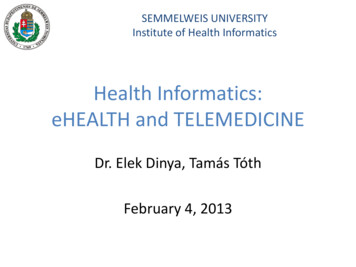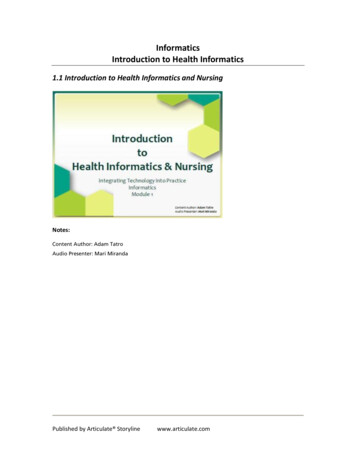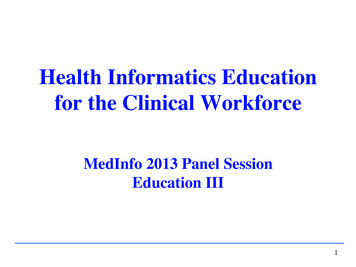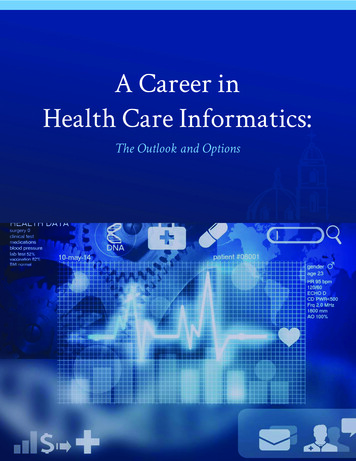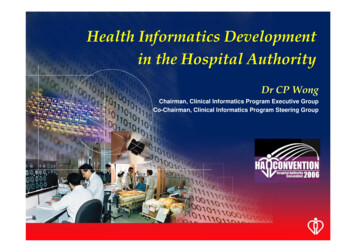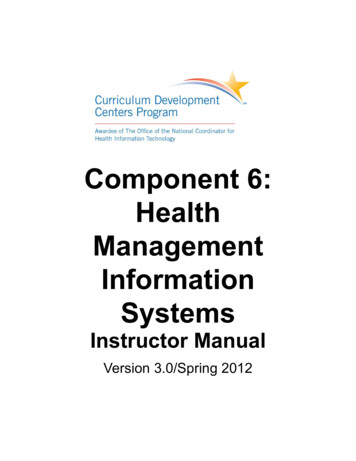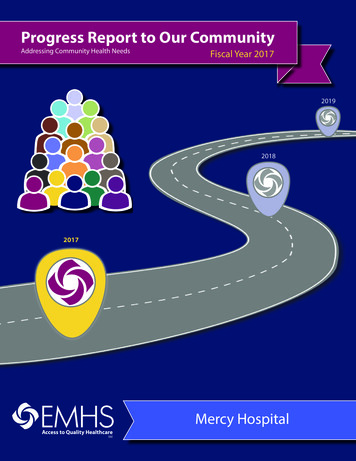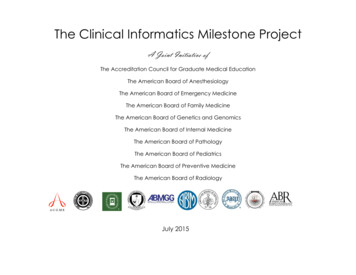
Transcription
The Clinical Informatics Milestone ProjectA Joint Initiative ofThe Accreditation Council for Graduate Medical EducationThe American Board of AnesthesiologyThe American Board of Emergency MedicineThe American Board of Family MedicineThe American Board of Genetics and GenomicsThe American Board of Internal MedicineThe American Board of PathologyThe American Board of PediatricsThe American Board of Preventive MedicineThe American Board of RadiologyJuly 2015
The Clinical Informatics Milestone ProjectThe Milestones are designed only for use in evaluation of the fellow in the context of their participation inACGME-accredited residency or fellowship programs. The Milestones provide a framework for assessment of thedevelopment of the fellow in key dimensions of the elements of physician competency in a specialty orsubspecialty. They neither represent the entirety of the dimensions of the six domains of physician competency,nor are they designed to be relevant in any other context.i
Clinical Informatics MilestonesChair: Christoph U. Lehmann, MDWorking GroupAdvisory GroupLaura Edgar, EdD, CAEPeter Embi, MDAdam Flanders, MDAnne Gravel Sullivan, PhDBruce Levy, MDTiffany MossSuzanne Powell, MDPenelope Tippy, MDJames Anderson, MDJames Arrighi, MDBeth Baker, MDPeter Carek, MD, MSJoseph Gilhooly, MDJulia Iezzoni, MDPhilip Shayne, MDV. Reid Sutton, MDMargaret Wood, MB, Ch.B.ii
Milestone ReportingThis document presents Milestones designed for programs to use in semi-annual review of fellow performance and reporting to theACGME. Milestones are knowledge, skills, attitudes, and other attributes for each of the ACGME competencies organized in adevelopmental framework from less to more advanced. They are descriptors and targets for fellow performance as a fellow movesfrom entry into fellowship through graduation. In the initial years of implementation, the Review Committee will examine Milestoneperformance data for each program’s fellows as one element in the Next Accreditation System (NAS) to determine whether fellowsoverall are progressing.For each period, review and reporting will involve selecting milestone levels that best describe a fellow’s current performance andattributes. Milestones are arranged into numbered levels. Tracking from Level 1 to Level 5 is synonymous with moving from noviceto expert in the subspecialty.Selection of a level implies that the fellow substantially demonstrates the milestones in that level, as well as those in lower levels(see the diagram on page v).Level 1: The fellow demonstrates milestones expected of an incoming fellow.Level 2: The fellow is advancing and demonstrates additional milestones, but is not yet performing at a mid-fellowship level.Level 3: The fellow continues to advance and demonstrate additional milestones, consistently including the majority ofmilestones targeted for fellowship.Level 4: The fellow has advanced so that he or she now substantially demonstrates the milestones targeted for fellowship. Thislevel is designed as the graduation target.Level 5: The fellow has advanced beyond performance targets set for fellowship and is demonstrating “aspirational” goalswhich might describe the performance of someone who has been in practice for several years. It is expected that onlya few exceptional fellows will reach this level.iii
Additional NotesLevel 4 is designed as the graduation target and does not represent a graduation requirement. Making decisions about readiness forgraduation is the purview of the fellowship program director. Study of Milestone performance data will be required before theACGME and its partners will be able to determine whether milestones in the first four levels appropriately represent thedevelopmental framework, and whether Milestone data are of sufficient quality to be used for high-stakes decisions.Examples are provided with some milestones. Please note that the examples are not the required element or outcome; they areprovided as a way to share the intent of the element.Some milestone descriptions include statements about performing independently. These activities must occur in conformity to theACGME supervision guidelines, as well as institutional and program policies. For example, a fellow who performs a procedureindependently must, at a minimum, be supervised through oversight.Answers to Frequently Asked Questions about Milestones are available on the Milestones web tonesFAQ.pdf.iv
The diagram below presents an example set of milestones for one sub-competency in the same format as the ACGME ReportWorksheet. For each reporting period, a fellow’s performance on the milestones for each sub-competency will be indicatedby selecting the level of milestones that best describes that fellow’s performance in relation to those milestones.Selecting a response box in the middle of alevel implies that milestones in that level andin lower levels have been substantiallydemonstrated.Selecting a response box on the line in between levelsindicates that milestones in lower levels have beensubstantially demonstrated as well as some milestonesin the higher level(s).v
Version 08/2014Clinical Informatics Milestones, ACGME Report WorksheetPatient Care 1: Technology AssessmentLevel 1Demonstrates knowledgeof the value of newtechnologyComments:Level 2Recognizes the need for aprocess in implementingnew technologyLevel 3Describes the process ofimplementing newtechnologyDescribes the cost-benefitanalysis process for newtechnologyParticipates in a costbenefit analysis for newtechnologyLevel 4Participates in new clinicalinformatics systemsselection, implementation,and validationLevel 5Acts as primary assessorfor new technology, andleads efforts for systemselectionDefends purchasingdecisions to peersNot yet achieved Level 1Copyright (c) Pending. The Accreditation Council for Graduate Medical Education, The American Board of Anesthesiology, The American Board of EmergencyMedicine, The American Board of Family Medicine, The American Board of Genetics and Genomics, The American Board of Internal Medicine, the AmericanBoard of Pathology, The American Board of Pediatrics, The American Board of Preventive Medicine, and The American Board of Radiology. All rights reserved.The copyright owners grant third parties the right to use the Clinical Informatics Milestones on a non-exclusive basis for educational purposes.1
Version 08/2014Clinical Informatics Milestones, ACGME Report WorksheetPatient Care 2: Clinical Decision Support SystemsLevel 1Recognizes the role ofclinical decision support toimprove patient careLevel 2Identifies basic principlesof effective clinicaldecision supportRecognizes the elementsof clinical decision makingIdentifies the principles ofdecision science as relatedto clinical decision makingComments:Level 3Participates in theimplementation anddeployment of a clinicaldecision supportinterventionLevel 4Evaluates (measures andanalyzes) the impact of aclinical decision supportinterventionLevel 5Develops and implementsa clinical decision supporttool and demonstrates theimpact on quality, safety,and costPerforms calculationsInterprets computer-based related to decision analysisrepresentation of a clinical (e.g., sensitivity,rule (e.g., basic Ardenspecificity, utility)syntax)Not yet achieved Level 1Copyright (c) Pending. The Accreditation Council for Graduate Medical Education, The American Board of Anesthesiology, The American Board of EmergencyMedicine, The American Board of Family Medicine, The American Board of Genetics and Genomics, The American Board of Internal Medicine, the AmericanBoard of Pathology, The American Board of Pediatrics, The American Board of Preventive Medicine, and The American Board of Radiology. All rights reserved.The copyright owners grant third parties the right to use the Clinical Informatics Milestones on a non-exclusive basis for educational purposes.2
Version 08/2014Clinical Informatics Milestones, ACGME Report WorksheetPatient Care 3: Impact of Clinical Informatics on Patient CareLevel 1Recognizes that clinicalinformatics tools directlyimpact patient careComments:Level 2Utilizes informatics toolsto coordinate anddocument key events inpatient careLevel 3Evaluates clinicalinformatics systems usedin documentation andcoordination of patientcare (e.g., usability,effectiveness)Level 4Participates in improvingthe clinical informaticssystems used indocumentation andcoordination of patientcareLevel 5Leads change in improvingthe clinical informaticssystems used indocumentation andcoordination of patientcareNot yet achieved Level 1Copyright (c) Pending. The Accreditation Council for Graduate Medical Education, The American Board of Anesthesiology, The American Board of EmergencyMedicine, The American Board of Family Medicine, The American Board of Genetics and Genomics, The American Board of Internal Medicine, the AmericanBoard of Pathology, The American Board of Pediatrics, The American Board of Preventive Medicine, and The American Board of Radiology. All rights reserved.The copyright owners grant third parties the right to use the Clinical Informatics Milestones on a non-exclusive basis for educational purposes.3
Version 08/2014Clinical Informatics Milestones, ACGME Report WorksheetPatient Care 4: Project ManagementLevel 1Recognizes theimportance of projectmanagement in thesuccessful execution ofinformatics projectsLevel 2Identifies resources andtools for projectsDescribes basic projectmanagement principlesLevel 3Applies basic projectmanagement principlesand toolsLevel 4Manages projectexpectations of end-usersand leadership whilebalancing competingprioritiesLevel 5Manages a project frominitiation to completion,including monitoring andappropriately adjustingbudget and timeline asneededMonitors project scopeand prevents or addressesuncontrolled changes orcontinuous growth inproject scopeComments:Not yet achieved Level 1Copyright (c) Pending. The Accreditation Council for Graduate Medical Education, The American Board of Anesthesiology, The American Board of EmergencyMedicine, The American Board of Family Medicine, The American Board of Genetics and Genomics, The American Board of Internal Medicine, the AmericanBoard of Pathology, The American Board of Pediatrics, The American Board of Preventive Medicine, and The American Board of Radiology. All rights reserved.The copyright owners grant third parties the right to use the Clinical Informatics Milestones on a non-exclusive basis for educational purposes.4
Version 08/2014Clinical Informatics Milestones, ACGME Report WorksheetPatient Care 5: Information System LifecycleLevel 1Recognizes thatinformatics systems needto be implemented,maintained, improved,and retiredLevel 2Identifies all stages of asystems lifecycleLevel 3Participates in a systemevaluation and theassessment of need fornew systemsParticipates in staging,prototyping, and testing anew system and in retiringexisting systemsComments:Level 4Participates in projectingand budgeting total costsof implementation,including purchasing,upgrading, training, and(when possible) retiring asystemLevel 5Assesses and improves theoutcomes of theimplementation of a newinformation systemNot yet achieved Level 1Copyright (c) Pending. The Accreditation Council for Graduate Medical Education, The American Board of Anesthesiology, The American Board of EmergencyMedicine, The American Board of Family Medicine, The American Board of Genetics and Genomics, The American Board of Internal Medicine, the AmericanBoard of Pathology, The American Board of Pediatrics, The American Board of Preventive Medicine, and The American Board of Radiology. All rights reserved.The copyright owners grant third parties the right to use the Clinical Informatics Milestones on a non-exclusive basis for educational purposes.5
Version 08/2014Clinical Informatics Milestones, ACGME Report WorksheetPatient Care 6: Assessing User NeedsLevel 1Recognizes user needs andtheir importance in thedesign andimplementation ofsystemsLevel 2States the methods ofassessing user needs inregards to systemsworkflow and informationmanagementDescribes usabilityframeworks and humaninterface design standardsComments:Level 3Participates in thedevelopment of arequirements documentLevel 4Participates in riskassessment and mitigation(e.g., Failure Mode andEffects Analysis)Level 5Improves user experiencewithin an existing systemApplies usabilityframeworks and humaninterface design standardsNot yet achieved Level 1Copyright (c) Pending. The Accreditation Council for Graduate Medical Education, The American Board of Anesthesiology, The American Board of EmergencyMedicine, The American Board of Family Medicine, The American Board of Genetics and Genomics, The American Board of Internal Medicine, the AmericanBoard of Pathology, The American Board of Pediatrics, The American Board of Preventive Medicine, and The American Board of Radiology. All rights reserved.The copyright owners grant third parties the right to use the Clinical Informatics Milestones on a non-exclusive basis for educational purposes.6
Version 08/2014Clinical Informatics Milestones, ACGME Report WorksheetMedical Knowledge 1: Clinical Informatics Fundamentals and ProgrammingLevel 1Demonstratesfundamental knowledge ofcomponents and usage ofinformation systems (e.g.,network, Internet,hardware, software)Level 2Demonstratesfundamental knowledge ofcomponents and usage ofhealth care informationsystems (e.g., ElectronicHealth Record [EHR], LabInformation System [LIS],Computerized ProviderOrder Entry [CPOE])Demonstrates basicknowledge ofprogrammingDemonstrates basicknowledge of databasesLevel 3Demonstrates basicknowledge of enterprisewide system architectureand integrationConverts a simplealgorithm as a program orpseudo codeDemonstrates knowledgeof the differentarchitecture of databasesDescribes the componentsand architecture of a datainterchange standard (e.g.,HL7)Level 4Converts a complexalgorithm into a programor pseudo codeCreates a simple relationaldatabaseInterprets the contents ofa health care datainterchange standardmessageLevel 5Demonstratescompetence in theidentification of changesneeded in systemarchitecture to optimizeoperational effectivenessIndependently designs andprograms systemsQueries and explorescomplex enterprisedatabases such as anenterprise data warehouse(EDW)Demonstrates basicknowledge of informaticsstandards andterminologiesComments:Not yet achieved Level 1Copyright (c) Pending. The Accreditation Council for Graduate Medical Education, The American Board of Anesthesiology, The American Board of EmergencyMedicine, The American Board of Family Medicine, The American Board of Genetics and Genomics, The American Board of Internal Medicine, the AmericanBoard of Pathology, The American Board of Pediatrics, The American Board of Preventive Medicine, and The American Board of Radiology. All rights reserved.The copyright owners grant third parties the right to use the Clinical Informatics Milestones on a non-exclusive basis for educational purposes.7
Version 08/2014Clinical Informatics Milestones, ACGME Report WorksheetMedical Knowledge 2: Leadership and Change ManagementLevel 1Demonstrates knowledgeof the need for leadershipand effective managementin health care systemsDemonstrates knowledgefor effective changemanagement in healthsystem interventionLevel 2Recognizes the differentleadership models andtheir valueRecognizes thecomponents oforganizational governance(e.g., processes,responsibility vs.authority)Recognizes changemanagement theory andstrategiesComments:Level 3Demonstrates skills foreffective leadershipRecognizes the elementsof effective management(e.g., conflict resolution)Assesses organizationalculture and readiness forchangeLevel 4Participates in anorganizational leadershipgroup/committeeLevel 5Leads an organizationalleadershipgroup/committeeApplies leadership skills toeffect a clinical informaticsinitiativeDevelops effectivestrategies for promotingadoption/optimization ofclinical informationsystemsParticipates in clinicalinformatics process usingchange managementtheoryNot yet achieved Level 1Copyright (c) Pending. The Accreditation Council for Graduate Medical Education, The American Board of Anesthesiology, The American Board of EmergencyMedicine, The American Board of Family Medicine, The American Board of Genetics and Genomics, The American Board of Internal Medicine, the AmericanBoard of Pathology, The American Board of Pediatrics, The American Board of Preventive Medicine, and The American Board of Radiology. All rights reserved.The copyright owners grant third parties the right to use the Clinical Informatics Milestones on a non-exclusive basis for educational purposes.8
Version 08/2014Clinical Informatics Milestones, ACGME Report WorksheetSystems-based Practice 1: Patient Safety and Unintended ConsequencesLevel 1Recognizes that clinicalinformation systems affectpatient safetyRecognizes the informaticsissues that can result innegative consequences(e.g., problems withpatient identification andmatching)Comments:Level 2Demonstrates knowledgeof how clinical informationsystems (e.g.,computerized physicianorder entry [CPOE]) canimprove patient safetyDemonstrates knowledgeof the etiology of negativeconsequences of clinicalinformation systemsLevel 3Identifies improvementsto patient safety utilizinginformation systemsLevel 4Participates in informaticssolutions to improvepatient safetyIdentifies potentialunintended consequencesof information systemsand processimplementationParticipates in informaticssolutions to addressnegative consequence(s)of using a clinicalinformation systemLevel 5Designs, implements, andanalyzes impact ofsolutions to improvepatient safetyNot yet achieved Level 1Copyright (c) Pending. The Accreditation Council for Graduate Medical Education, The American Board of Anesthesiology, The American Board of EmergencyMedicine, The American Board of Family Medicine, The American Board of Genetics and Genomics, The American Board of Internal Medicine, the AmericanBoard of Pathology, The American Board of Pediatrics, The American Board of Preventive Medicine, and The American Board of Radiology. All rights reserved.The copyright owners grant third parties the right to use the Clinical Informatics Milestones on a non-exclusive basis for educational purposes.9
Version 08/2014Clinical Informatics Milestones, ACGME Report WorksheetSystems-based Practice 2: Resource UtilizationLevel 1Interprets anorganizational chart and isaware of employmentcontracts and benefitsDescribes the basics andpurposes of budgetsLevel 2Knows the personnel andlines of reporting in theorganizationRecognizes differentbudget types (e.g., capital,operating budgets)Demonstrates knowledgeof the basics of practicefinance (e.g., Part A andPart B, Centers forMedicare & MedicaidServices [CMS])Demonstrates basicknowledge of contractingand negotiationLevel 3Describes the process ofpersonnel managementand employment laws(e.g., interview questions,Family and Medical LeaveAct, termination policies)Level 4Creates a basic jobdescription andparticipates in employeeinterviews/performanceevaluation (real orsimulated)Identifies key elements ofhospital and informationtechnology (IT) budgetsParticipates in an IT budgetcycle exercise (draft,defend, and proposelogical cuts and/oradditions)Describes how clinicalinformation systems cansupport practice financeDescribes contracting andnegotiation related tohealth IT purchases andconsultingLevel 5Manages personneleffectivelyDevelops and manages aninformatics budgetAssists in thedevelopment/maintenanceof documentation tools tostreamline the billingprocessesParticipates in a contractnegotiationComments:Not yet achieved Level 1Copyright (c) Pending. The Accreditation Council for Graduate Medical Education, The American Board of Anesthesiology, The American Board of EmergencyMedicine, The American Board of Family Medicine, The American Board of Genetics and Genomics, The American Board of Internal Medicine, the AmericanBoard of Pathology, The American Board of Pediatrics, The American Board of Preventive Medicine, and The American Board of Radiology. All rights reserved.The copyright owners grant third parties the right to use the Clinical Informatics Milestones on a non-exclusive basis for educational purposes.10
Version 08/2014Clinical Informatics Milestones, ACGME Report WorksheetSystems-based Practice 3: Workflow and Data Warehouse/RepositoryLevel 1Demonstrates awarenessof the importance ofworkflow in clinicalinformaticsDemonstrates awarenessof the need for andbenefits of a datawarehouse or repositoryComments:Level 2Recognizes the elementsand processes of aworkflow analysisLevel 3Participates in a workflowanalysis to inform a clinicalinformatics solutionLevel 4Devises improvements orsolutions based onworkflow analysisRecognizes and describesthe principles of datawarehousing and analysisPerforms queries ofclinical data warehousesor repositoriesInterprets data queryresultsDescribes the creation andpopulation of a datawarehouse (e.g., datamigration, indexing, andvalidation)Analyzes data for clinical,quality, safety, or researchpurposesLevel 5Implements animprovement or solutionbased on a workflowanalysisAnalyzes and querieshealth informationexchangesNot yet achieved Level 1Copyright (c) Pending. The Accreditation Council for Graduate Medical Education, The American Board of Anesthesiology, The American Board of EmergencyMedicine, The American Board of Family Medicine, The American Board of Genetics and Genomics, The American Board of Internal Medicine, the AmericanBoard of Pathology, The American Board of Pediatrics, The American Board of Preventive Medicine, and The American Board of Radiology. All rights reserved.The copyright owners grant third parties the right to use the Clinical Informatics Milestones on a non-exclusive basis for educational purposes.11
Version 08/2014Clinical Informatics Milestones, ACGME Report WorksheetPractice-based Learning and Improvement 1: Recognition of Errors and Discrepancies — Displays attitudes, knowledge, and practices thatfoster improvement of patient care from study of errors and discrepanciesLevel 1Recognizes and reflectsupon health system errorsRecognizes that errors inclinical informatics impactpatient careAcknowledges and takesresponsibility for errorswhen recognizedLevel 2Actively observes theidentification of healthsystem errors and theprocess of correctiveaction planning forpotential solutionsDescribes variations oferrors and the broaderimpact on patient careRecognizes limits of ownknowledgeLevel 3Demonstrates competenceby participating inidentifying health systemerrors and implementingpotential solutionsAs part of a team,participates inimplementing a solution toresolve information systemerrors that impact patientcareLevel 4Drafts a solution toresolve an informationsystem error that impactspatient careDemonstrates significantawareness of own gaps inknowledge as well aspersonal strengths andweaknessesLevel 5Teaches and leads inidentification of healthsystem errors andimplementing potentialsolutionsDevelops and implementsa solution to resolveinformation system errorsthat impact patient careReflects upon errors in agroup settingComments:Not yet achieved Level 1Copyright (c) Pending. The Accreditation Council for Graduate Medical Education, The American Board of Anesthesiology, The American Board of EmergencyMedicine, The American Board of Family Medicine, The American Board of Genetics and Genomics, The American Board of Internal Medicine, the AmericanBoard of Pathology, The American Board of Pediatrics, The American Board of Preventive Medicine, and The American Board of Radiology. All rights reserved.The copyright owners grant third parties the right to use the Clinical Informatics Milestones on a non-exclusive basis for educational purposes.12
Version 08/2014Clinical Informatics Milestones, ACGME Report WorksheetPractice-based Learning and Improvement 2: Scholarly Activity — Analyzes and appraises pertinent literature, applies scientific method to identify,interprets evidence-based medicine, and applies it clinicallyLevel 1Develops knowledge of thebasic principles of research(i.e., demographics,institutional review board[IRB], human subjects),including how research isconducted, evaluated, andapplied to patient careLevel 2Applies evidence-basedmedicine in presentations,such as at journal club and,as appropriate, identifiesresearch project early infellowshipLevel 3Applies evidence-basedmedicine principles inpresentations at local orregional meetingsLevel 4Applies evidence-basedmedicine principles inpresentations at national orinternational meetingsand/or prepares and submitsarticles to peer-reviewedpublicationsLevel 5Educates others throughjournal clubs or mentoringresearch projectsApplies for peer-reviewedfunding for original researchIndependently conductsoriginal informatics researchComments:Not yet achieved Level 1Copyright (c) Pending. The Accreditation Council for Graduate Medical Education, The American Board of Anesthesiology, The American Board of EmergencyMedicine, The American Board of Family Medicine, The American Board of Genetics and Genomics, The American Board of Internal Medicine, the AmericanBoard of Pathology, The American Board of Pediatrics, The American Board of Preventive Medicine, and The American Board of Radiology. All rights reserved.The copyright owners grant third parties the right to use the Clinical Informatics Milestones on a non-exclusive basis for educational purposes.13
Version 08/2014Clinical Informatics Milestones, ACGME Report WorksheetProfessionalism 1: Professionalism — Demonstrates honesty, integrity, and ethical behaviorLevel 1Behaves honestly andrecognizes the concepts ofethical behavior,occasionally requiringguidance; seeks counselwhen ethical questionsariseRecognizes the conceptsof respect, compassion,and empathy with regardto patients and users ofclinical systemsLevel 2Acknowledges personalerrors and puts theinterests of patients andtheir families first; engagesin ethical behaviorRecognizes professionalresponsibility for reportingpersonal and team errorsand completesinstitutional reportingprocessLevel 3Models appropriateprofessional conductwithout external guidanceDemonstrates respect,compassion, and empathywith regard to patientsand users of clinicalsystems, even in difficultsituationsLevel 4Recognizes lapses inprofessionalism andprovides assistance toother team members andcolleaguesLevel 5Models honesty, respect,compassion, and empathy,even in complex situationsPromotes respect,compassion, and empathyin others with regard topatients and users ofclinical systemsDemonstrates respect,compassion, and empathywith regard to patientsand users of clinicalsystemsComments:Not yet achieved Level 1Copyright (c) Pending. The Accreditation Council for Graduate Medical Education, The American Board of Anesthesiology, The American Board of EmergencyMedicine, The American Board of Family Medicine, The American Board of Genetics and Genomics, The American Board of Internal Medicine, the AmericanBoard of Pathology, The American Board of Pediatrics, The American Board of Preventive Medicine, and The American Board of Radiology. All rights reserved.The copyright owners grant third parties the right to use the Clinical Informatics Milestones on a non-exclusive basis for educational purposes.14
Version 08/2014Clinical Informatics Milestones, ACGME Report WorksheetProfessionalism 2: Professionalism — Demonstrates responsibility and follow-through on tasksLevel 1Completes assigned taskson timeLevel 2Level 3Dependably completesAnticipates team needsassigned tasks in a timelyand assists as neededmanner; assists teammembers when requested;respects assignedschedulesComments:Level 4Anticipates team needsand takes leadership roleto independentlyimplement solutionsLevel 5Exemplifies effective,reliable management ofmultiple competing tasks;is source of support andguidanceNot yet achieved Level 1Professionalism 3: Professionalism — Gives and receives feedbackLevel 1Receives feedbackconstructivelyComments:Level 2Accepts feedbackconstructively andmodifies practice inresponse to feedbackLevel 3Provides constructivefeedbackLevel 4Exemplifies giving andreceiving of constructivefeedback; encourages andactively seeks feedback toimprove performanceLevel 5Models giving andreceiving of constructivefeedback; encourages andactively seeks feedback toimprove performanceNot yet achieved Level 1Copyright (c) Pending. The Accreditation Council for Graduate Medical Education, The American Board of Anesthesiology, The American Board of EmergencyMedicine, The American Board of Family Medicine, The American Board of Genetics and Genomics, The American Board of Internal Medicine, the AmericanBoard of Pathology, The American Board of Pediatrics, The American Board of Preventive Medicine, and The American Board of Radiology. All rights reserved.The copyright owners grant third parties the right to use the Clinical Informatics Milestones on a non-exclusive basis for educational purposes.15
Version 08/2014Clinical Informatics Milestones, ACGME Report WorksheetProfessionalism 4: Professionalism — Demonstrates responsiveness and sensitivity to individuals’ (e.g., patients, system users, etc.) distinctcharacteristics and needsLevel 1Level 2Level 3Level 4Level 5Respects individuals’Embraces diversity andDemonstrates culturalExemplifies culturalModels culturaldiversity and autonomy;respects vulnerablecompetency; recognizescompetency; recognizescompetency andrecognizes vulnerablepopulations; aware ofcultural differences thatcultural differences andrecognition of culturalpopulationspotential for bias or culturalmay affect clinical care,identifies and avoidsdifferences that may affectdifferences to affect clinicaldiagnoses, or thebiases that may affectclinical care or diagnoses,Recognizes
informatics tools directly impact patient care Utilizes informatics tools to coordinate and document key events in patient care Evaluates clinical informatics systems used in documentation and coordination of patient care (e.g., usability, effectiveness) Participates in improving the clinical
